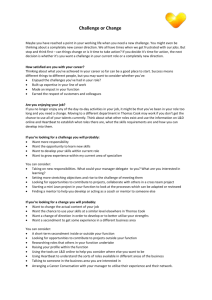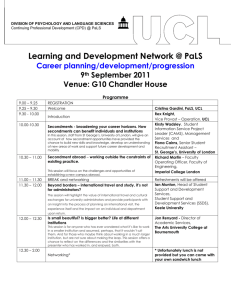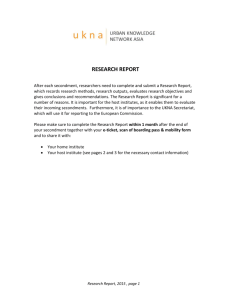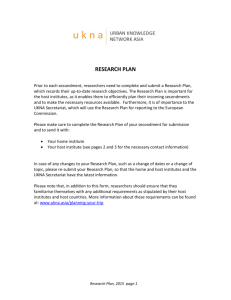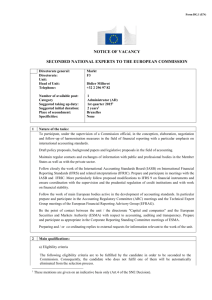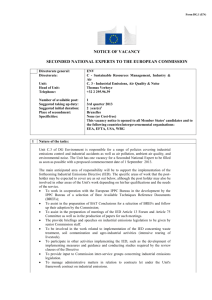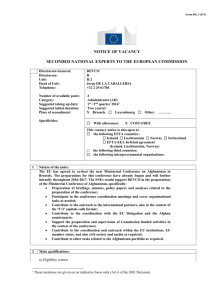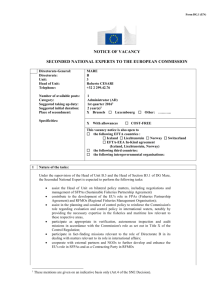Internal secondment guidelines - University of South Australia
advertisement
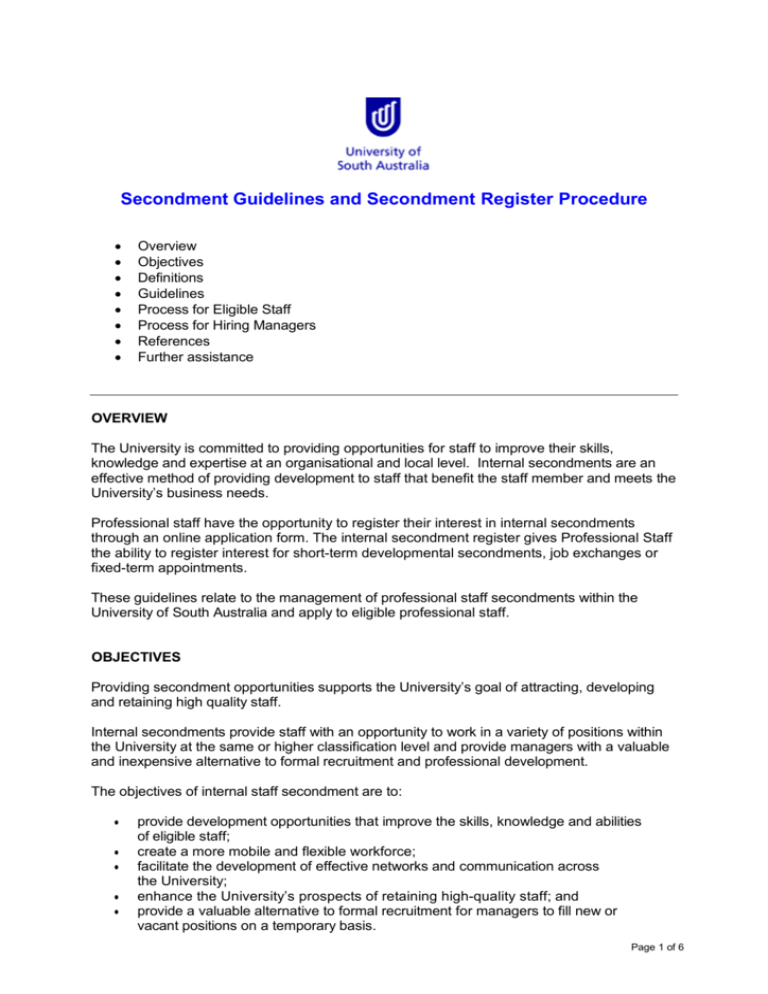
Secondment Guidelines and Secondment Register Procedure • • • • • • • • Overview Objectives Definitions Guidelines Process for Eligible Staff Process for Hiring Managers References Further assistance OVERVIEW The University is committed to providing opportunities for staff to improve their skills, knowledge and expertise at an organisational and local level. Internal secondments are an effective method of providing development to staff that benefit the staff member and meets the University’s business needs. Professional staff have the opportunity to register their interest in internal secondments through an online application form. The internal secondment register gives Professional Staff the ability to register interest for short-term developmental secondments, job exchanges or fixed-term appointments. These guidelines relate to the management of professional staff secondments within the University of South Australia and apply to eligible professional staff. OBJECTIVES Providing secondment opportunities supports the University’s goal of attracting, developing and retaining high quality staff. Internal secondments provide staff with an opportunity to work in a variety of positions within the University at the same or higher classification level and provide managers with a valuable and inexpensive alternative to formal recruitment and professional development. The objectives of internal staff secondment are to: • • • • • provide development opportunities that improve the skills, knowledge and abilities of eligible staff; create a more mobile and flexible workforce; facilitate the development of effective networks and communication across the University; enhance the University’s prospects of retaining high-quality staff; and provide a valuable alternative to formal recruitment for managers to fill new or vacant positions on a temporary basis. Page 1 of 6 The objectives of internal secondment support the Workforce Planning Framework, and operate in conjunction with University policies and associated guidelines including: • • • • Performance Management (HR-25.1) Remuneration and Reward (HR-28.1) Staff Recruitment and Selection (HR-27.1) Equal Opportunity (C-2.4) **Please note: Whilst every effort will be made to find a suitable secondment opportunity for all applicants, registering interest does not guarantee a placement through secondment. DEFINITIONS Internal secondment: The temporary transfer of an eligible professional staff member to another position within the University for a mutually agreed duration. The terms “internal secondment” and “secondment” are used interchangeably. Eligible staff: Continuing and fixed-term (on case-by-case basis) professional staff who have successfully completed probation. Substantive position: The position which a staff member normally occupies. Substantive manager: The manager responsible for the work area in which the staff member’s substantive position is located. Host manager: The manager responsible for the work area in which the secondment position is located. Secondment Agreement: A written agreement between the staff member, the substantive manager and the host manager that details the conditions of the secondment. Redeployee: A continuing staff member of the University whose substantive position has been declared surplus to requirements and for whom an alternative position is being sought. Expressions of Interest: An advertisement / communication requesting prospective applicants to indicate their interest in a position. Normally Expressions of Interest are circulated to a specific work area/s via email or to the University community via the All Staff Job Vacancies email by the Director: Human Resources. GUIDELINES 1. Initiating an Internal Secondment 1.1. Managers may use an internal secondment as an alternative to a formal recruitment process where: • a new position is identified; or • a vacant position requires backfilling. 1.2. Secondments are for a limited time (normally up to 12 months) and have a specified end date at which time the staff member would normally return to their substantive position (refer to 1.6). 1.3. To ensure that a seconded staff member is appropriately remunerated and to assist with managing expectations, it is recommended that the position description is evaluated before a staff member is seconded to the position. However, the position Page 2 of 6 description must be evaluated if the secondment is to extend beyond 12 months. Refer to the Classification of Professional, Grounds and Document Services Staff Positions 1.4. Prior to initiating an internal secondment, consideration is given to the suitability of redeployees for placement into positions. 1.5. An internal secondment may be initiated in a number of ways, including: • a vacancy becoming available and staff being matched via the secondment register; or • a manager identifying through the performance management process an opportunity for a staff member who is performing above expectations; or • a manager targeting a specific sector of the University in order to provide a development opportunity to staff in that area or to capture a particular set of skills; or • an individual discussing secondment opportunities within their current or an alternative work area. It is preferable that the staff member discusses a potential secondment with their substantive manager prior to seeking a secondment opportunity or lodging an application for a position in an alternative work area. However, where this has not occurred, the host manager must advise the staff member that they will confidentially discuss the possibility of the secondment with that staff member’s substantive manager. Where a host manager wishes to approach a specific staff member for a secondment, as a courtesy, it is recommended they discuss the possibility of the secondment with that staff member’s substantive manager once a conversation has been had with the intended staff member. 1.6. If a continuing staff member is offered a secondment for a term that is: • 12 months or less, they should be seconded to the position and their substantive position held (with agreement from the substantive manager, host manager and the staff member); or • Greater than 12 months, one of the following options may apply; o the staff member is seconded to the position and their substantive position is held (with agreement from the substantive manager, host manager and the staff member); or o the staff member relinquishes their substantive position, their continuing status and employment conditions specific to continuing staff and accepts the secondment as a fixed-term contract. In this situation, the staff member has no right of return to their former substantive continuing position. This needs to be clarified with the staff member before they make a decision. This is a matter to be negotiated on a case by case basis between the substantive manager and the staff member. Managers are encouraged to consult with Human Resources prior to approving such an arrangement. 1.7 1.8 A continuing staff member should not be employed under a fixed-term contract, unless they are relinquishing their substantive position and their continuing status. This would normally be initiated by the staff member in writing. If the initial secondment is extended for a period greater than 12 months, it cannot be expected that the substantive manager hold the staff member’s substantive position. This will be a matter of negotiation with the substantive manager. Secondments for fixed-term staff members are not common and will be assessed on a case by case basis. Consideration will be given to the length of the fixed-term contract, the length of the secondment and organisational needs. Page 3 of 6 • • Generally, a fixed-term staff member who wishes to accept a long-term secondment will relinquish their current fixed-term contract and accept the secondment as a new fixed-term contract. In this situation, the staff member has no right of return to the original fixed-term contract position. Managers must consult with Human Resources prior to approving a secondment for a fixed-term staff member. 2. Negotiation and Approval 2.1. The University will support secondment opportunities for continuing staff where they meet the objectives of secondment unless the substantive manager can demonstrate a strong business case for not supporting the secondment. 2.2. Although secondments are not an automatic entitlement for staff, managers are encouraged to release their staff for internal secondment opportunities, where practicable, as a means of career development. Consideration should be given to: • the impact on workforce planning, workloads and staffing arrangements; • the potential impact on the business; • the number of successive secondments in which the staff member has previously been engaged; • coverage of the staff member’s duties and skills for the period of secondment; • the investment in skills development for the staff member and the work area; and • how the secondment is linked to the development objectives outlined in the staff member’s performance plan. 2.3. Conditions of a secondment will be negotiated by the host manager in consultation with Human Resources, and require approval by the Delegated Authority as per the Vice Chancellor’s Authorisations. 2.4. A secondment will only occur where the host manager, substantive manager and staff member agree to the conditions of the secondment and a Secondment Agreement is endorsed. Refer to Section 3 - Secondment Agreement. 3. Secondment Agreement 3.1. The Secondment Agreement should be initiated by the host manager. 3.2. Terms of Agreement • Before the secondment commences, the terms of the secondment need to be negotiated and agreed to by the host manager, the substantive manager and the staff member and detailed in a Secondment Agreement (refer Internal Secondment Agreement – Professional Staff). The terms of secondment will include start and finish dates, level of position, reporting relationships, return of substantive position and leave arrangements • A Position Description should be provided to the staff member prior to commencement and should be attached to the Secondment Agreement and relevant attachments should be provided to the host manager, the substantive manager and the staff member. 3.3. Amendments to Secondment Agreement • Amendments to the Secondment Agreement (for example, early return or extention) must be agreed to by the host manager, the substantive manager and the seconded staff member • Where a secondment is extended so that the proposed duration of the secondment will exceed 2 years, the host manager should consider the true nature of the position and whether it is required on a continuing basis. 3.4. Leave • The taking of previously accrued recreation leave, long service leave, or leave accrued through a flexible work arrangement (ie purchased leave) should be negotiated prior to the acceptance of the secondment. This may include how much leave will be taken during the term of the secondment. Page 4 of 6 • Host managers are encouraged to develop a leave management plan for the seconded staff member to ensure they are able to take recreation leave accrued during the period of the secondment whilst still in the work area. Staff members must negotiate any pre-planned leave (including Extra Recreation Leave or Study Leave) prior to the commencement of the secondment 4. Other 4.1. The seconded staff member must be inducted to the new work area. 4.2. Within the first month of the secondment, a performance management plan should be agreed. The normal performance management process will apply. Refer to the Performance Development and Management website. 4.3. If a structural change impacts on the seconded staff member’s substantive position during the course of the secondment, the substantive manager will consult with the seconded staff member as outlined in the managing change process in the applicable industrial instrument. 4.4. The seconded staff member should give their substantive manager at least four weeks notice prior to the end of the agreed secondment period of their intention to return or otherwise to their substantive position. 5. Human Resources Administration 5.1. Once the terms of the secondment have been negotiated, agreed to and signed by the host manager, substantive manager and the staff member, the Secondment Agreement should be placed on the staff member’s personal file and a copy provided to the host manager, substantive manager, recruitment hub and the staff member. 5.2. A New Appointments and Position Movements form (HRIS 002) should be completed and forwarded to Payroll Services to update the Human Resources Information System. PROCESS FOR ELIGIBLE STAFF The process to register interest in Secondment Opportunities is as follows; 1. The staff member discusses their desire to register for secondment opportunities with their manager as part of their Performance Development and Management Plan (PDM) 2. Preferably with manager support, the staff member will register their interest in secondments by applying via the online Secondment Register by: o Completing the registration form including; o Selecting the areas of competency/interest and; o Uploading a current copy of their CV 3. The Secondment database will be refreshed in March each year and staff will be required to re-register their interest if they wish to be considered for future secondments. 4. Staff can withdraw their registration of interest in secondments from the register at any time. PROCESS FOR HIRING MANAGERS When vacancies become available in the local area, it is preferred the Secondment Register database be reviewed as a first point of call to search for potential internal candidates eligible to fill the role. The process for hiring managers to fill secondment opportunities will be as follows; 1. Hiring manager contacts the recruitment hub via phone on x21700 or email Page 5 of 6 recruitment@unisa.edu.au with the details of the position vacant 2. The recruitment hub performs a key word search on the secondment database matching candidates skills and interests again the position 3. The recruitment hub sends a package of potential secondee candidates to the hiring manager which includes a copy of the staff member’s registration form and CV 4. The hiring manager reviews the package from the recruitment hub and contacts candidates to set up interviews 5. If a match is found, the Secondment Agreement is negotiated between the hiring manager, substantive manager and staff member. This includes a release date 6. Hiring manager notifies recruitment hub of final decision so the database can be updated REFERENCES • University of South Australia Enterprise Agreement 2014 FURTHER ASSISTANCE Management and staff may seek further advice from: • • • • • Their immediate supervisor The designated HR contact for their area The Recruitment Team Human Resources The Human Resources website Reviewed: June 2015 Page 6 of 6
